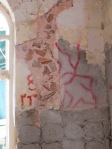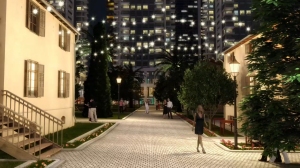The remains of a 19th century German Christian Colony now turn into Tel Aviv’s modern heart

An old agricultural colony from the 19th century built by a Christian Sect from Germany now experiences a revival as a commercial area.
Between cement mills, fences and tarpaulin banners one can spot a bunch of ancient houses. What looks like a huge construction site once used to be the living space of the Templer Society, a German Protestant sect, which settled down in Palestine in the late 19th century.
 We enter one of the houses through an entrance with no doors. We walk into a room with high ceilings and two pillars in the middle. On the foot of one of the pillars sit two people scraping of the color with little trowels. On the capital of the pillars you see biblical inscriptions in German and Arabic which have recently been exposed by artists who are renovating the house.
We enter one of the houses through an entrance with no doors. We walk into a room with high ceilings and two pillars in the middle. On the foot of one of the pillars sit two people scraping of the color with little trowels. On the capital of the pillars you see biblical inscriptions in German and Arabic which have recently been exposed by artists who are renovating the house.
This inconspicuous, dilapidated house has a long history to tell. Once it was the old Gemeindehaus of the Templer colony “Sarona”.
In 1868 members of the Pietist movement which has its roots in Baden Wüttenberg came to Palestine and founded 7 settlements, including the colony of “Sarona” which was situated in what today is the center of Tel Aviv.
The Templers believed that their movement would help rebuild the Temple in the Holy Land and promote the second coming of Christ.
In their agricultural colony they built workshops, barns and even a winery and also sold their products. German and Arabic was taught in their schools, in order to assimilate into Palestinian society. At its height, the Templer community numbered 2,200 members.
During the 3rd Reich the settlers supported the Nazis, admiring Hitler’s Regime as the newborn Germany and hoping for a strengthening of German culture all over the world. They set up local NSDAP groups and received subsidies from the Nazi government, teachers aligned with the Nazi regime took over Templer schools.
After the outbreak of the Second World War, the British Mandate transformed the Templer settlements of Sarona, Wilhelma, Betlehem and Waldheim into internment camps where enemies such as Italians, Hungarians and Palestian-Germans, including the Templers, were held captive. At the end of the war the prisoners were deported, many of the Templers moved to Australia where one still finds Templer communities today. Ín 2009 approximately 1000 Templers lived in Germany and Australia.
After the Israeli Independence in 1948 the old Templer Houses of Sarona were used as governmental offices – Later some of the houses were turned into offices for the Israeli military. The old Gemeindehaus of Sarona was used as a post office.
In 2008, during the widening of the Kaplan Street, 5 houses of the village were moved in a very complicated procedure, as you can see in this video:
On the wall of the old Gemeindehaus you can see red lines marking the cracks in the wall which resulted from the move.
At the beginning of the 21rst century the restoration of the Templer houses began and is scheduled to finish next year. Workshops, Schools and Gemeindehaus will be used, this time with a different intention:
This once agricultural colony is going to be a commercial area, with offices, cultural institutions and a shopping area.
“God’s Neighbours” – A Cannes award winning Israeli Movie you should watch

Of prayers and beatings
Avi and his two best friends, Kobi and Yaniv, wear their kippas with pride. As devout Orthodox Jews of the Hassidic ‘Breslov’ they attend rabbinical classes and go to synagogue on Shabbat. But that’s not all; they take care that others do too.
Religious fanaticism combined with suburbia- induced boredom turns these three guys into guardians of the Torah. In Bat Yam, a city south of Tel Aviv, they ensure their neighborhood obeys god’s rules and is a religious place – in their own way….
In the very first scene, a bunch of teenagers party in the street on Shabbat night, when you are supposed to rest. Avi and his friends help to restore the sacred tranquility by taking their baseball bats and beating them up.
A deep insight into Israeli society and the Jewish Faith
Insightful and non-judgemental, director Meny Yaesh examines the many contradictory facets of Israeli society and the Jewish Faith.
The violent and thoughtful scenes of the film touch the main issues in contemporary Israeli society- In particular, the clashes between Jews and Arabs as well as religious and secular Israelis points out the imposing barricade which is build on religious fanaticism, history and social inequalities.
Inner conflicts
It also takes a deeper look on the inner contradictions and conflicts of those who have their life determinded by the rules of god.
Avi, played by Roy Assaf, falls in love with a girl who isn’t religious; she doesn’t wear appropriate clothes and does not respect Shabbat. His feelings towards her leave him with remorsed and confused. Despite all the obstacles the relationship between the two deepens. Although not certain if on a religious or a secular way: They smoke joints together but don’t touch each other. 
The many scenes pointing out contradictions sometimes end up bordering on the ridiculous; The ambivalence of the characters, for example Avi- who is violent- but totally likable at the same time, leaves you a bunch of new questions. God’s neighbours definitely is a movie that keeps you thinking about it for a while.
The movie has won the Gaul’s Society of Authors, Directors and Composers award in the 2012 Cannes Film Festival.
It will be screened at the
Hamburg film festival (6/10)
Finnish film festival (17.8)
Varsovie film festival (12.10)
and will be be commercialy released in France during 2013






